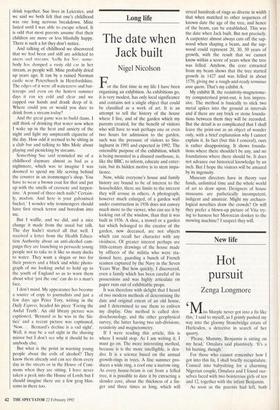Long life
The date when Jack built
Nigel Nicolson
Now, while everyone's house and family history are bound to be of interest to the householder, there are limits to the interest they will arouse in others. A photograph, however much enlarged, of a garden wall under construction in 1936 does not convey much more to the viewer, who can see it by looking out of the window, than that it was built in 1936. A shoe, a trowel or a garden hat which belonged to the creator of the garden, now deceased, are not objects which can recall her character with any vividness. Of greater interest perhaps are 18th-century drawings of the house made by officers of the militia who were sta- tioned here, guarding a bunch of French seamen captured by the Navy in the Seven Years War. But how quickly, I discovered, even a family which has been careful of its possessions and was highly articulate on paper runs out of exhibitable props.
It was therefore with delight that I heard of two modern methods of determining the date and original extent of an old house, and I determined to use them to enliven my display. One method is called den- drochronology, and the other geophysical survey, the latter having two sub-divisions, resistivity and magnetometry.
If I were reading this article, this is where I would stop. As I am writing it, I must go on. The more interesting method, because is is the more intelligible, is den- dro. It is a science based on the annual growth-rings in trees. A fine summer pro- duces a wide ring, a cool one a narrow ring. As every house-behm is cut from a felled tree, it is possible to date it by extracting a slender core, about the thickness of a fin- ger and three times as long, which will reveal hundreds of rings so diverse in width that when matched to other sequences of known date the age of the tree, and hence of the beam, can be established. This was the date when Jack built. But not precisely. A carpenter almost always cuts off the sap- wood when shaping a beam, and the sap- wood could represent 20, 30, 50 years of growth, with the result that we cannot know within a score of years when the tree was felled. Anyhow, the core extracted from my beam shows that the tree started growth in 1427 and was felled in about 1570, giving me a rough-and-ready terminus ante quem. That's my exhibit A.
My exhibit B, the resistivity-magnetome- try computerised print-out, is less impres- sive. The method is basically to stick two metal spikes into the ground at intervals and if there are any brick or stone founda- tions between them they will be recorded. But the detail is so complicated that I shall leave the print-out as an object of wonder only, with a brief explanation why I cannot explain it. In fact (but this I conceal), ours is rather disappointing. It shows founda- tions where there shouldn't be any, and no foundations where there should be. It does not advance our historical knowledge by an inch. But I hope the visitors will be amazed by its ingenuity.
Museum directors have in theory vast funds, unlimited time and the whole world of art to draw upon. Designers of house museums are pathetically incompetent, indigent and amateur. Might my archaeo- logical novelties draw the crowds? Or will they prefer a blown-up picture of Vita try- ing to harness her Moroccan donkey to the mowing machine? I suspect they will.


















































 Previous page
Previous page